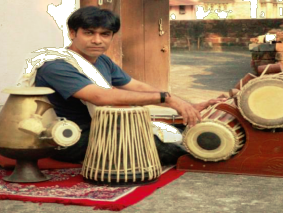
Subhasis Ghosh with ancient percussion instruments that he revived.
New Delhi: An ambidextrous percussionist Subhasis Sabyasachi Ghosh, engaged in the field of music for the last 32 years, has been reviving the forgotten art of percussion instruments and made his mission of life to promote and propagate such traditional rare instruments for posterity.
Also read: A renaissance of extinct instruments
“Once I went to the Kolkata Museum and saw a section on Lupto Badajzontro (extinct instruments). I thought about it and finally made up my mind to revive extinct percussion instruments,” he said. For this, first, he had to understand the physical structure of these instruments and guess what kind of sound quality they could output.
Once Subhasis resolved to revive such percussion instruments, there was no looking back. He designed and introduced many extinct percussion instruments such as Shruti, Aawaz, Chhar Taranga, and Maha Mridanga and got them patented. On this achievement, he says, “First of all I had to understand the physical structure of these instruments and tried to guess what kind of sound quality it could output”. According to him, a true musician is one such person who is proficient in playing various traditional percussion instruments in our generation.
Inspired by the epic Mahabharat, where the great Arjuna could fight or shoot an arrow with either hand with the same accuracy, Subhasis perfected the art of playing Pakhawaj and Jori ( a rare percussion instrument), in the same way. He developed the art of playing Indian percussion instruments like ‘Pakhawaj-Jori-Tabla‘ by reversing the sides despite maintaining the rhythm as in normal performance. For this accomplishment, he was recognised by the Limca Book of Records -2011.
Following are the details of the once-extinct percussions that were revived by Subhasis:
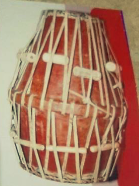
Ancient Mridang (Made of Clay): This percussion instrument has been played in India for over 2000 years but is rarely found these days. The present-day Mridangs are made of wood but earlier it was made of clay. There were lots of historical references to clay-made Mridang during the age of Samrat Ashoka, the age of the Gupta Empire, during the reign of Samrat Harshvardhan, Maharaja Sasanka, Samrat Prithviraj Chauhan and Empire Akbar.
Subhasis uses this Mridang for his performances. It is about 500 years old which he got from his grandfather.
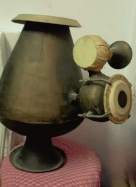
Abja or Awaz: It is mentioned in the “Sangeet Ratnakar” book by Sarangdev (compiled during the 13th century AD). It was described as some barrel drum water pitcher-like percussion instrument which was open-ended without any skin covering. During the Mughal age, there were similar instruments which used to create a lot of sound when played and were called “Awaz” by the musicologists of that era.
Subhasis re-created the instrument by dint of his hard efforts and has been using it as a solo as well as an accompaniment instrument.

Punjab Pakhawaj or Jori (Puda and Dhama): This percussion instrument was created by the 5th Sikh Guru Arjan Dev in the 16th century before his untimely execution by Emperor Jehangir in the present day Lahore (Pakistan). It looks like a Pakhawaj segregated into two halves – the two halves are called Kuda and Dhama respectively and the pair together is called “Jori”. Nowadays Subhasis has been playing this rare instrument after reviving it.
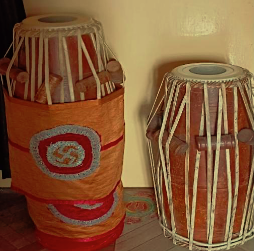
Mahamridanga: In Mahabharata, we can see that when Arjuna visited King Virata, he played mridanga which was called Mahamridanga. During the Mahabharata period, people were perhaps tall and that’s why their instruments were made in the same way. (Vedic texts tell us that during the Treta Yug the average height of a person was eight feet. Therefore, they made their musical instruments to suit their height).
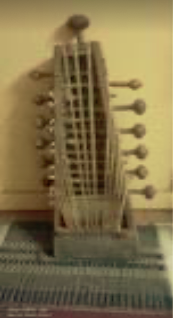
Chhratrang: It’s a unique musical instrument devised by Sabyasachi. Flat leather lace or hide thongs usually about 1/4 inch long are used for the construction of musical instruments like Tabla, and Pakhawaj. These act as tension laces for lowering or raising the pitch of the Tabla Pakhawaj.
“I used to practice Pakhawaj and it often happened while I was trying to harmonise the tune with a small hammer as is done by musicians, often the hammer used to fall on the ‘Chhar‘ creating a peculiar sound which was very soothing to the ear. This made me think about how an instrument made of ‘Chhar’ only can be constructed.
Sruti: A conglomeration of ‘Pakhawaj‘ and ‘Mridangam‘ producing both their mixed tunes but the sounds are so different, that they resemble neither of the two. “One can use it like a Tabla. When we play this instrument, surprisingly sometimes we can split and sometimes we can join. There lies the magic!” Subhasis said.
It is indeed heartening to note that a community of musicians and instrument-makers involved in playing and crafting musical instruments are more and more into preserving important aspects of our culture, including not only musical styles but also associated oral and written literature.
– global bihari bureau






